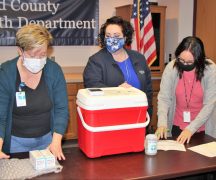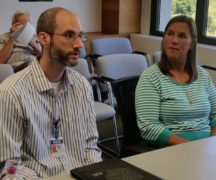By JAN LARSON McLAUGHLIN
BG Independent News
Area hospitals put out an SOS today, asking that local residents get vaccinated against COVID. Leaders of six hospitals that normally compete for patients came together to ask for help.
“This is a collaboration like this community has never seen,” Sean Savage said at the beginning of a press conference organized by the V Project, a grassroots initiative in Northwest Ohio to motivate and vaccinate residents in the region.
The physicians on the virtual panel offered data on the drain being placed on their systems. Currently at Mercy Health, unvaccinated people make up 92% of the patients hospitalized with COVID and 96% of those dying from the virus. University of Toledo Medical Center is seeing the same type of numbers.
The cases have resulted in exhausted health care systems, cancellation of elective surgeries, and bypassing of ambulances.
After two years of COVID, the medical systems are nearing a breaking point.
More than 100 people listened during the virtual press conference which included comments from leaders of Wood County Hospital, Mercy Health, UTMC, ProMedica, McLaren St. Luke’s, the Toledo Clinic, plus the Wood and Lucas county health departments.
“When is the last time a hospital asked you for help?” Savage asked. Public service announcements have been created to send out the same messages that healthcare workers are hoping people heed.
Get vaccinated. Get booster shots. Wear masks. Social distance. Wash hands.
“I’ve seen first hand at the bedsides the toll this has taken,” said Dr. James Tita, of Mercy Health.
The Omicron variant has brought on the fourth surge of COVID – with 750,000 new cases being reported daily in the U.S.
“It has really put stress on hospitals,” Tita said.
Local hospitals are experiencing an “unprecedented shortage” of healthcare workers, and are struggling to provide the level of care patients deserve, he said.
While the earlier surges of COVID affected older patients, this one is hitting the young, Tita said.
“We’re seeing much younger patients who are just as sick,” he said.
Emergency departments are seeing long wait times, and often patients are spending days in the ER before a hospital bed becomes available. Tita asked that people not come to overworked emergency departments to get tested for COVID.
Dr. Brian Kaminski, of ProMedica, said the high volume of needs are affecting patient care throughout the region.
“It’s led to an overwhelmed state,” he said.
“Patients start to pile up in the waiting rooms,” Kaminski said.
In the last month, every hospital in the region has had to go on EMS bypass, diverting ambulances to other facilities. And there have been multiple times when all area hospitals have been on EMS bypass at the same time, creating a “red alert,” Kaminski said.
When that happens, ambulance services must adopt different standard of care protocols. Rather than taking every patient who wants hospital care to an emergency room, the EMS has to prioritize.
“We want to see everybody who feels they need to be transported to the ER,” Kaminski said. But that is no longer possible at times. “We’re having to operate under different standards.”
Wood County Hospital is seeing the same issues, said Dr. Wayne Bell, who came to the U.S. from Canada in 1995. “I never thought I would see it here,” he said of patients being stacked for care.
Last week, Wood County Hospital performed 1,000 PCR tests for COVID, with a 42% positivity rate.
“We all seem to know someone now who had COVID,” Bell said.
While vaccinated people are being infected by the highly transmissible Omicron mutation, most are avoiding serious illnesses, according to Michael Ellis, from UTMC. Well over 90% of the COVID deaths at that hospital are unvaccinated patients, he said.
Dr. Stephen Bazeley, of McLaren St. Luke’s, said Ohio’s vaccination rate is about 60%, which is lower than neighboring states. That hospital is also seeing primarily unvaccinated patients on ventilators.
“If we are going to beat this, we really need to get more people vaccinated,” Bazeley said.
Dr. Karl Fernandes, of the Toledo Clinic, said hospital nurses, respiratory therapists and doctors are “fighting tooth and nail” to treat COVID patients.
“It’s a strain on the hospital system,” he said.
Fernandes said it is not too late for hold-outs to get the vaccines. “The statistics are quite clear,” he said, that vaccines protect people from severe symptoms and death. “Those who are on the fence, get vaccinated.”
The current demand on local hospitals is “unsustainable,” Fernandes said.
Children are being affected at a much higher rate than with previous COVID variants. More than 580,000 pediatric cases were reported nationally last week, according to local pediatrician Dr. Jennifer DeLucia.
“We are seeing a lot more cases in children,” DeLucia said. Hardest hit are ages 4 years and younger. “That age group is not eligible for vaccinations.”
Older children are 10 times more likely to be hospitalized with COVID if they are not vaccinated, she said.
DeLucia also advised that parents not add to strain on emergency departments unless necessary.
“Stay clear of the ER unless the child is having trouble breathing,” she said.
Savage noted that 103 area pediatricians have signed onto the V Project’s push to increase vaccination rates locally.
“We need to get that word out,” he said.
On Monday, Wood County reported 842 new COVID cases and 21 more COVID hospitalizations since Thursday, according to the Wood County Health Department.
“There’s a lot of COVID in our communities, circulating,” said Wood County Health Commissioner Ben Robison.
If more people were to get vaccines and boosters, they could change the trajectory of the disease locally.
“This is a huge thing we can do to help our hospitals,” Robison said.
Lucas County Health Department is also seeing a surge, with up to 967 new cases being reported a day.
“Our numbers are staggering in Lucas County,” said Lucas County Health Commissioner Eric Zgodzinski.
Toledo Mayor Wade Kapszukiewicz said he understands the public’s desire to be done with COVID.
“We are understandably fatigued and worn out after two years of dealing with the pandemic,” he said.
But he asked local residents to listen to the hospitals that are “speaking with one voice.”
“Let the healthcare providers help you,” Kapszukiewicz said.
“We have relied on our hospital system for decades to take care of us,” Savage said to local healthcare professionals. “The community needs to recognize and acknowledge that it’s really up to us individually to help you.”
A list of vaccine clinics in the region can be found at vproject.org.





